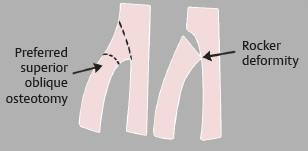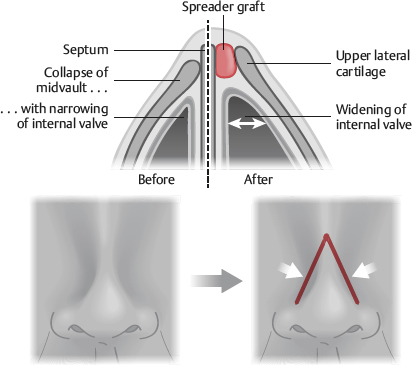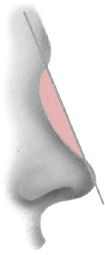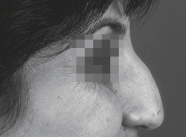46. Secondary Rhinoplasty
Richard Y. Ha, Lily Daniali, Cecilia Alejandra Garcia de Mitchell, Bahman Guyuron
INDICATIONS
POSTOPERATIVE FUNCTIONAL OR AESTHETIC DEFORMITY
■ Poor preoperative diagnosis
• Failure to properly identify the structural problem resulting in functional compromise or aesthetic imbalance1
■ Inappropriate surgical planning or inadequate technique resulting in distortion of supporting osteocartilaginous framework
■ Problematic wound healing
• Prolonged edema, ecchymosis, unfavorable scarring, obstructive or restrictive webbing, and occasionally hyperesthesia
PATIENT DISSATISFACTION
■ Undesirable functional or aesthetic outcome
• Breathing difficulties and asymmetry are most common complaints.2
■ Inadequate preoperative counseling with regard to postoperative course, recovery time, desired and expected outcomes
■ Unrealistic expectations
• Even with appropriate preoperative counseling, some patients continue to have unrealistic expectations
• If not identified, these patients will be dissatisfied with their results regardless of the outcome.3,4
■ Postoperative deformity and patient dissatisfaction do not always correlate.
MOST COMMON DEFORMITIES OR PROBLEMS
■ Displacement/deviation of anatomic structures
■ Underresection by overly cautious surgeons
■ Overresection by overly aggressive surgeons5
■ Contour irregularities secondary to disruption of framework or unfavorable scarring
■ Prosthetic complications including infection, extrusion, inflammation, palpability, or transillumination (e.g., in dorsal silicone implants)
SURGICAL OBSTACLES6
■ Scarring of the subcutaneous tissues resulting in adherence to the underlying cartilaginous framework and destruction of tissue planes
■ Osteocartilaginous distortion or damage requiring reconstruction for structural support
■ Limited sources of cartilage grafts secondary to previous harvest of septal or conchal cartilage
CHANGES IN SKIN THICKNESS
■ Thin skin in some patients, which is less forgiving of minor underlying deformities
• Prone to graft extrusion
■ Thick skin secondary to prolonged edema or scarring, which is less malleable and will not show desired framework changes as easily
■ Compromised vascularity secondary to previous surgical incisions and scarring
SURGICAL APPROACHES
ENDONASAL/CLOSED APPROACH
■ Pros
• Decreased postoperative edema and scarring because limited dissection
■ Indications
• Isolated deformities that can be addressed independent of the overall framework
• Severely scarred nose where vascularity is a significant concern
EXTERNAL/OPEN APPROACH
■ This is the preferred approach for secondary rhinoplasty.7
■ Pros
• Provides maximal exposure for adequate visualization
• Facilitates complete release of tissue attachments causing anatomic distortion
• Facilitates precise diagnosis and correction of deformities under direct visualization
• Allows direct hemostatic control
■ Cons
• Increased postoperative edema
■ Placement of transcolumellar incision
• If original scar is well hidden but at incorrect level of columella, ignore original scar and place second incision at appropriate location
PREOPERATIVE ASSESSMENT AND PLANNING
This is supplementary to the evaluation performed for a primary rhinoplasty, as presented in Chapter 45.
MEDICAL HISTORY
■ All previous nasal surgeries
• Obtain previous operative reports if possible to determine graft availability, presence of prosthetic material or hardware, and previous techniques or findings that may assist in evaluation and operative planning.
■ History of trauma
■ Allergies
■ Cocaine/drug use
■ Screen for body dysmorphic disorder (BDD) (see Chapter 1)
• Mental disorder involving a distorted body image, defined as:
► Preoccupation with an imagined physical deformity OR
► Vastly exaggerated concern of a minimal physical deformity
• In 50% of patients with BDD, the nose is the primary complaint.8,9
• BDD occurs in secondary rhinoplasty consultations in about 12% of cases, and in 2%-7% of all primary cosmetic patient consultations.8,9
• Plastic surgeons are often the first to encounter these patients; thus recognizing and addressing it are essential.
► A psychiatry consult may be warranted.
CAUTION: Avoid reoperation in BDD patients.10
SENIOR AUTHOR TIP: It is crucial to make sure that the secondary rhinoplasty patient’s concerns are real and match what the surgeon sees in severity. Exaggerated concerns should be carefully assessed by asking the patient to rate the flaw on the scale of 1-10, 10 being the best. Disparity in rating beyond 3-4 points should be considered a red flag.
COMPREHENSIVE NASAL AND FACIAL ANALYSIS
■ As described in the primary rhinoplasty chapter (Chapter 45), with special attention to common secondary deformities:
■ Bony pyramid
• Excessive narrowing or convexity
► Secondary to inadequate alignment or splinting of bones after osteotomy
• Irregularities/stairstep deformity
► Because of unplanned fracture sites
• Rocker deformity (Fig. 46-1)

Fig. 46-1 Rocker deformity.
► Occurs from inadequate placement of medial osteotomy, resulting in a wide upper dorsum
■ Midvault/upper lateral cartilages
• Asymmetry of dorsal aesthetic lines
• Nasal deviation
• Inverted-V deformity (Fig. 46-2)

Fig. 46-2 Inverted-V deformity.
► Midvault collapse leading to visibility of the the caudal edge of the nasal bones
♦ This edge or line forms an upside down or inverted V.
► Results from overresection of the dorsal midvault and upper lateral cartilages or inadequate infracture of the nasal bones
• Saddle nose deformity (Fig. 46-3)

Fig. 46-3 Saddle nose deformity.
► Excessively depressed upper nasal and midvault regions secondary to overresection
■ Supratip area
• Polly beak deformity11
► Convexity located just cephalad to the nasal tip
► Secondary to overresection of the noncartilaginous caudal dorsum, underresection of the cartilaginous nasal dorsum and/or excessive scar formation in the dead space of the supratip area (Fig. 46-4)

Fig. 46-4 Polly beak deformity. Postoperative profile view of a secondary rhinoplasty patient with a supratip deformity caused by both an underprojected tip and an underresected caudal dorsum.
• Bulbous or boxy tip deformity
• Pinched nasal tip deformity
► Results from collapsed alar rims after disruption of lateral crural support
► From loss of tip support: Disruption of lower lateral cartilages (LLCs) and/or intercartilaginous attachments
• Overrotation
► Obtuse nasolabial angle
• Asymmetry of tip-defining points
► Secondary to inadequate placement of tip sutures or unrecognized damage to cartilage
• Infratip lobule
► Excessive infratip lobule projection
♦ From excessive length and buckling of middle crus or crura
► Lack of definition
♦ Middle crus too wide
► Deformity may result from prominent caudal septum or obtuse septal angle.14
■ Alae
• Widened base
• Alar rim collapse resulting in impaired external valve competency (Fig. 46-5)

Fig. 46-5 Alar rim collapse. Alar rim collapse caused by lack of lower lateral cartilage support.
► Loss of LLC integrity and failure to reconstruct framework at initial surgery
► Clinically assessed by palpating preoperative resistance of alae to gentle compressive force
► Weakness is useful for diagnosing either established or predisposition to alar collapse.
• Alar retraction
• Alar flaring
► Widened base
• Notching
► Secondary to inadequate placement or closure of previous incisions, scarring, and failure to place supporting grafts
■ Columella
• Retraction, deviation, and/or inferior bowing
■ Intranasal
• Airway occlusion most common underdiagnosed and untreated deformity in secondary rhinoplasty
► Breathing difficulties most common complaint in patients presenting for revision2
• Septum
► Deviation
► Graft availability
• Turbinates
• Internal nasal valve competency
► May have been medialized by osteotomy15
SENIOR AUTHOR TIP: History of septoplasty does not necessarily mean depletion of the cartilage in the septum. A thorough examination may result in discovery of sufficient cartilage in the septum.
FORMULATE TREATMENT PLAN
■ Surgical approach
■ Augmentation or resection
■ Correction of distortion/displacement/irregularities
■ Need for removal of prosthetic materials
■ Source and quantity of structural graft materials
• Rib cartilage
• Ear cartilage
• Septal cartilage
• Iliac/calvarial bone
• Alloplastic materials (controversial)
■ Delay any secondary surgery for at least 12 months.
• Ensure maximal resolution of edema, scar maturation, and improved vascularity.
• May consider early intervention within first 12 days postoperatively only if gross abnormality present or significant technical error noted16
■ Share preoperative analysis and treatment plan with patients.
• Use visual imagery: Photos, computer imaging, or onlay tracing
• Increases communication to establish realistic expectations and surgical goals
INFORMED CONSENT
NONSURGICAL TREATMENT
■ Observation
■ Injectable fillers for mild augmentation or contour irregularities
SURGICAL TREATMENT
■ Open versus closed rhinoplasty
TECHNIQUE
■ Reconstruction of the nasal osteocartilaginous framework is the foundation for successful secondary rhinoplasty.
■ Keep in mind skin quality, graft availability, effects of scarring, and vascularity.
SENIOR AUTHOR TIP: The most common reason for a residual caudal deviation after the primary and even secondary septorhinoplasty is failure to eliminate the redundant overlapping dislodged portion of the caudal anterior septum to allow repositioning the septum in the midline.
Stay updated, free articles. Join our Telegram channel

Full access? Get Clinical Tree




